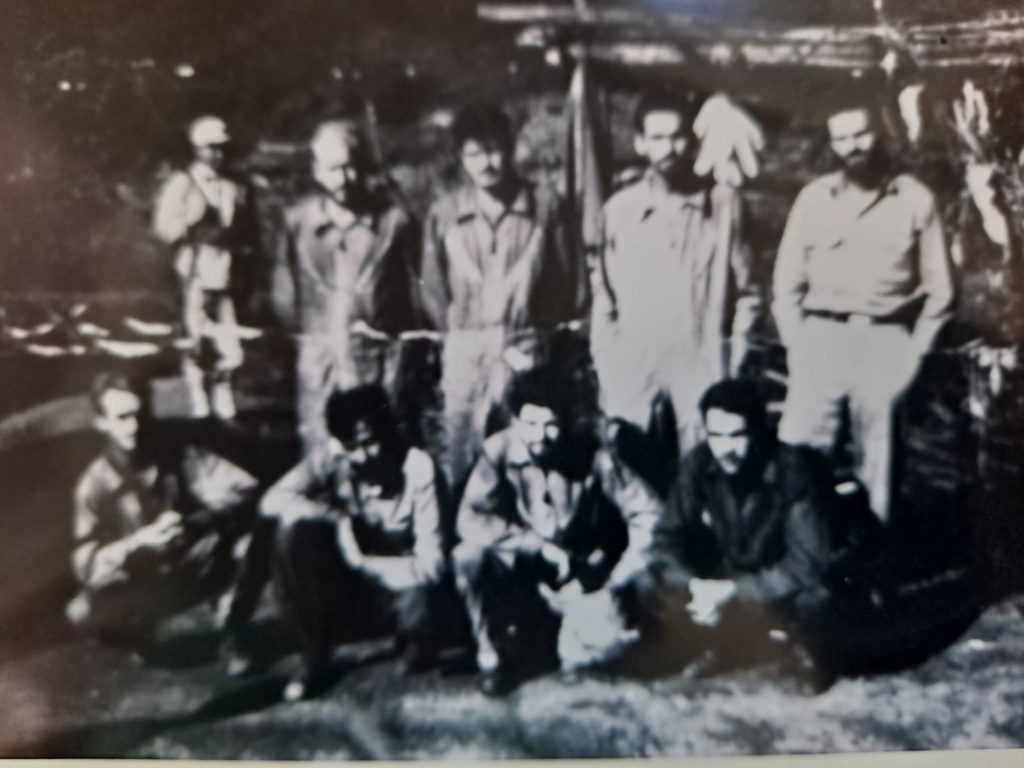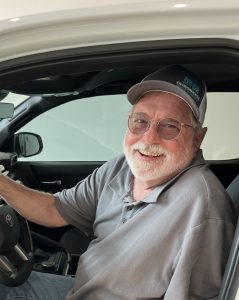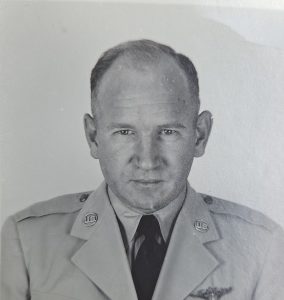Veterans Day falls on Nov. 11th. As I pondered how to commemorate this occasion, it occurred to me that one way is simply to tell a veteran’s story. If the desire is to honor veterans in general, then seeing one doing his sacrificial duty for his country is a good way to remind us of the contributions of all veterans.
And given that the veteran whose story I know best was my own uncle, C. L. Mullins, now deceased, I share below the highlights of his service years, and beyond. His career was such that he is buried in Arlington National Cemetery.
Born in Tulsa, Okla., in 1921, C.L. entered into military service with the breakout of World War II. In that conflict, he served out of England in the U.S. Army Air Corps’ 8th Air Force, with the “First Over Germany” 306th Bomb Group, flying many missions as a crewman on a B-17 in the 369th Bomb Squadron, aka the “Fightin’ Bitin’” unit.
C.L., known in those days as “Moon” Mullins, re-upped following the war, becoming a career serviceman, and when the Korean War came along, he again flew missions over enemy territory, this time as a flight engineer on a B-29, with the Air Force’s 305th Bomb Group.
On one of those missions, his B-29 was hit in mid-air, and the entire crew was forced to bail out, parachuting into enemy territory, where they were quickly captured. Their North Korean captors eventually handed them over to Chinese troops who were marching prisoners north, during winter, across North Korea to China, where the Americans would be placed into a prison camp. It was a brutal march, one on which those who could not keep up, perhaps due to injuries, would be left for dead, if not summarily shot and killed. An American pilot who was among the prisoners, James R. Fiser, was badly injured from shrapnel. He had nearly died already, before this march began, and as the march progressed, he would fall further behind each day, struggling to reach their camp late at night, long after the others had stopped for the day.
He would have died, certainly. His fellow airmen knew it. To help him along could have meant that his helper would perish, as well. But something happened that got him to China, and to that camp, and to a long life and an Air Force career that saw him reach the rank of colonel. Moon Mullins, maybe the sturdiest of the prisoners, chose, against much attempted dissuasion, to aid Fiser along, sometimes actually carrying him, but otherwise supporting and aiding him, every day of the march. There were days when Mullins and Fiser dragged into camp at midnight, exhausted, hours after everyone else had settled in.
When it appeared that Moon would not cease in these efforts, and that he along with Fiser would both die on the march, others among the American unit stepped in, doing their part too, and with the efforts of all, in rotation, Fiser made it to the Chinese prison camp, where would begin a dreadful two-year ordeal that cost many American lives. At one point, Mullins, who was one of the fortunate few who had a good pair of boots, was asked to give up his boots so that another solder might wear them in an escape attempt that was being planned. C.L. gave up the boots—that’s the ethos of that era, and that generation. The escape attempt failed and C.L. spent the remainder of the imprisonment shoeless, but that was the condition of many who were there.
Surviving the coldest nights of the coldest winters was a brutal experience, and marked maybe the most grim moments they collectively faced. Sometimes the prisoners performed makeshift medical operations on those needing them, with the doctor using a knife fashioned from a bootshank, and no anesthetic. Men did what men had to do.
But Mullins and Fiser both came home, at war’s end, in starved condition, along with many others.
Many years later—this was a week or two after my uncle had passed away—Col. Fiser telephoned me and introduced himself and told me the story in full detail (a story my uncle C.L. had never told me), his main point being that he owed his life to Moon Mullins.
C.L. went on to serve 19 years, total, in the Air Force, later finding work among the commercial airlines, as many Air Force retirements were wont to do. He was a beloved figure among his family. He never married, but he made a good life for himself and probably saw more of the world than almost any of his contemporaries.
When he reached a point in life when he could no longer adequately take care of himself, C.L. opted to retire in the U.S. Soldiers and Airmen’s home in Washington, D.C. This was in the 1990s.
Shortly before he moved in, an incident occurred there that is worth retelling here, because it shows the character of the kind of men who dwelled there.
At the entrance to the compound there stood a guard shack, where everyone entering by vehicle checked in. Just inside, just beyond the guard shack, there were some World War II-vintage artillery and other war-time hardware, displayed on concrete slabs. A World War II tank stood prominently among the relics there.
The home, beautiful as it was, lie within a neighborhood that had long since declined. Directly across the street from the entrance stood a house that had become a den of drug-dealing.
One day, a whacked-out drug dealer opened fire, from that house, shooting at the guard shack. The guard, struck by one of the rounds, slumped to the floor, unable to move. He was able, however, to get on his radio or phone (I’m not sure which) and contact personnel within the soldier’s home. He told them his plight. Meanwhile, the gunman across the street kept firing.

This fuzzy photo was taken in September 1951 by the captors of the B-29 crew. That’s a Chinese guard in upper left. These airmen, desperate to get word out that they had been captured (and were not dead), managed to steal the photo and somehow get it smuggled out across the lines and into the hands of U.S. personnel. C.L. Mullins is in the second row, at left. Pilot James R. Kiser is second row, second from right.
The Home began placing emergency calls to the police. No police would respond. Some reportedly scoffed at the report. More calls were made. Still, no responses. Retired soldiers called the mayor’s office. They merely got the brush-off. This era was during the tenure of controversial mayor Marion Berry, who years before had himself been convicted for crack use and served time.
So no help was coming. No one in the Soldiers Home could safely traverse the distance to the guard shack from the building nearest it, to rescue their downed companion. There was great anxiety for the plight of the guard, who might still catch a fatal round.
The word went out through the Soldiers Home. Does anyone here know how to drive that tank?
As luck would have it, there was a retired serviceman there who had operated that very model of tank during his military career.
The tank was approachable from the nearest building. The tank stood between the shack and the first building on the grounds. Men from the home were able to get gasoline, plus the tank operator, to the tank. They fueled and tried the engine. Amazingly, they got it started.
That man drove that tank out past the guard shack, out past the entry gate, and into the street. There was no ammo in the tank, of course, but that didn’t matter. The tank operator crossed the street. He drove straight into the house. The tank knocked down and crushed the house. By this time, the shooter had fled (probably at the moment he saw the tank in motion). The tank operator drove back and forth over the house until it was crushed flat to the ground.
In the days that followed, there arose a horrible squall from the mayor’s office, but the soldiers would have nothing of it. And they suffered no consequences of it. But the newspapers never carried the story. Sounds a little bit like the 2020s.
I’ve been there, to the Home at 3700 N. Capital Street NW. I’ve seen the shack. Seen the tank. I’ve met the men and heard their story.
When you want things done, call on a veteran, even a retired veteran. If you want to express your gratitude for your freedom and your way of life, thank a veteran.
Jesse Mullins, editor of Permian Basin Oil and Gas Magazine, spent innumerable hours, often days, fishing with, traveling with, playing dominoes with, and listening to stories from his uncle C.L., a member of the Greatest Generation.
Related: Donation Founds Texas Techs First Veterans Legal Clinic











